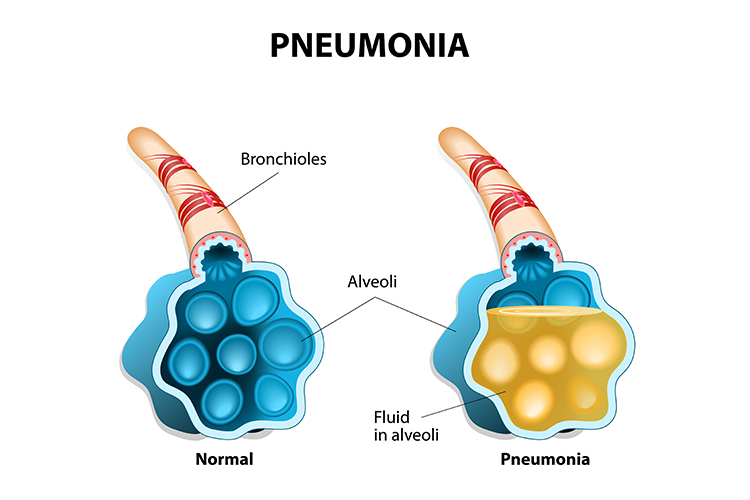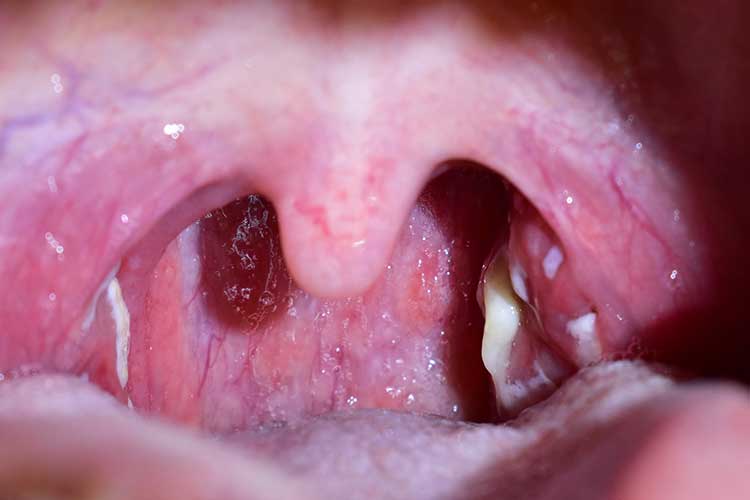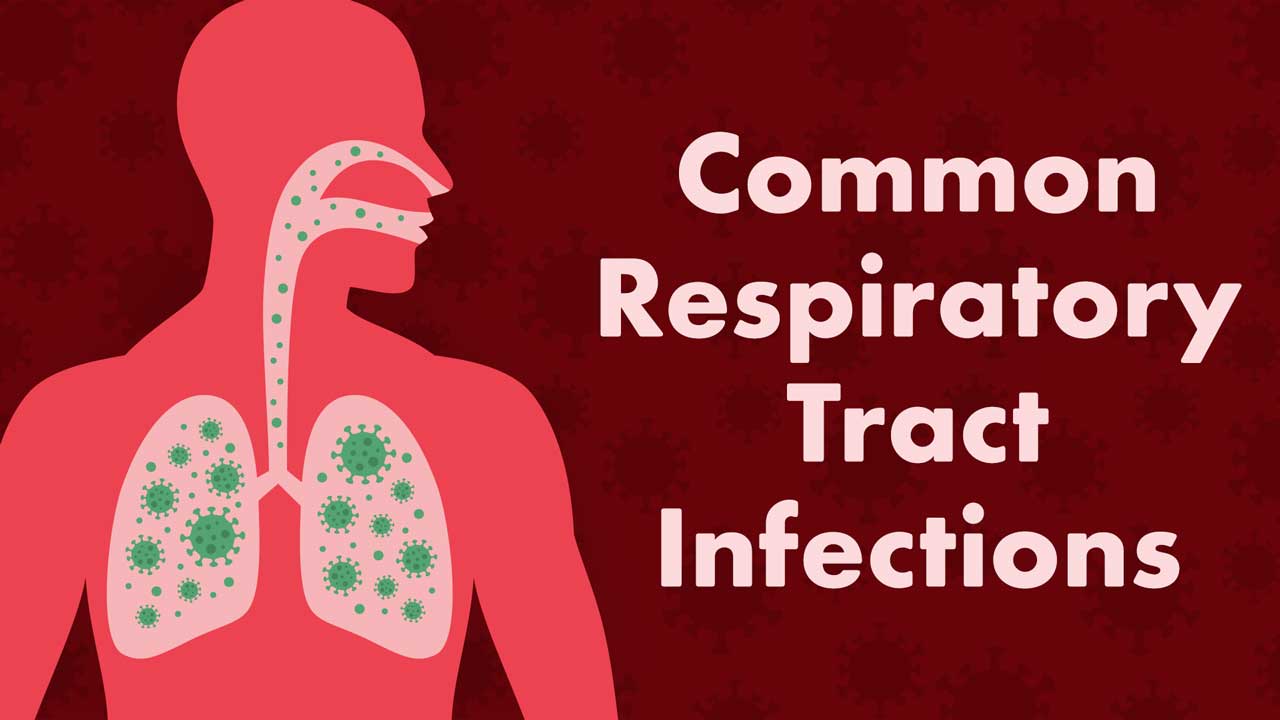The following article aims to help re-familiarise you with the different symptoms and presentations of the most commonly seen respiratory illnesses so that you can be confident in the care you provide.
What is a Respiratory Tract Infection?
Respiratory tract infections (RTIs) are various infections that affect parts of the respiratory system, such as the sinuses, throat, airway or lungs (NHS 2024a).
RTIs are separated into two categories depending on the area of the respiratory system they affect:
- Upper respiratory tract infections affect the sinuses and throat.
- Lower respiratory tract infections affect the airways and lungs.
(NHS 2024a)
Lower RTIs are generally longer-lasting and more serious (NHS 2024a).

How do Respiratory Tract Infections Spread?
RTIs are generally transmitted by direct contact with a contaminated surface or an infected person expelling droplets into the air via coughing, sneezing or talking (SA Health 2022).
Refer to Infectious Diseases: How Do You Break the Chain? to learn more about the modes of infection transmission and how to prevent the spread of infectious diseases.
Common Respiratory Tract Infections
Below is an overview of some common RTIs. Please note this is not an exhaustive list.
Common cold
Type: Upper RTI
Cause: Viruses
Common symptoms:
- Sore throat
- Runny nose
- Sneezing
- Cough
- Headache.
Treatment: No specific treatment.
The common cold is the most prevalent contagious disease in Australia. It can be caused by over 200 different viruses, most of which belong to the rhinovirus or coronavirus families.
Colds can affect the ears, nose and throat. They are generally not considered serious and will usually resolve on their own. However, they may lead to secondary infections in some cases, particularly in children.
Further information: The Common Cold: Just How Common is it?
(Lung Foundation Australia 2022; Healthdirect 2024a; Healthy WA 2018)
Influenza
Type: Upper or lower RTI
Cause: Viruses
Common symptoms:
- Sore throat
- Fever
- Cough
- Body aches
- Fatigue
- Gastrointestinal symptoms (more common in children).
Treatment: Preventative vaccination.
Influenza (the flu) is similar to the common cold but is generally more severe with a very sudden onset. In some cases, it can lead to life-threatening complications.
Those who are at an increased risk of serious complications include older adults over 65, children under 2, pregnant people and those who are immunocompromised.
Further information: Influenza: Everything You Need to Know This Flu Season
(QLD Government 2024; NHS 2023a; CDC 2024)
Pneumonia
Type: Lower RTI
Cause: Viruses, bacteria or fungi
Common symptoms:
- Chest pain
- Cough
- Fever
- Fatigue
- Difficulty breathing
- Loss of appetite.
Treatment: Usually treated with antibiotics. Severe cases may require hospitalisation.
Pneumonia is an infection that causes inflammation of the alveoli (air sacs) in one or both lungs. The alveoli fill with secretions and fluid, decreasing the ability for oxygen to be transported across the tissue to adequately oxygenate vital organs. Patients may experience shortness of breath and may require oxygen therapy and ventilatory support.
Pneumonia can be a serious and potentially fatal infection, with young children, older adults and those with pre-existing health conditions most at risk of complications such as pleurisy, lung abscess or sepsis.
According to the World Health Organisation (2022), pneumonia accounts for 14% of deaths of children aged under five years of age. In 2019, it contributed to the deaths of 740,180 children in total.
As the immune system naturally weakens over time, older adults become more at risk of developing pneumonia as they age.
Pneumonia may present as a relapse after a cold or flu.
Further information: Pneumonia Symptoms, Signs and Treatment
(WHO 2022; NHS 2023b; Lung Foundation Australia 2024; Gamache 2024)

Sinusitis
Type: Upper RTI
Cause: Bacteria or viruses
Common symptoms:
- Pain, swelling and tenderness around cheeks, eyes and forehead
- Blocked nose
- Loss of smell or taste
- Thick, green or yellow mucus
- Headache
- Fever
- Bad breath.
Treatment: Decongestant nasal spray or drops, and salt water sprays or solutions.
Sinusitis is an inflammation of the nasal sinuses. It generally presents as a secondary infection after a cold or untreated allergies.
Sinusitis generally resolves on its own after a few weeks.
(ASCIA 2024; NHS 2024b)
Bronchitis
Type: Lower RTI
Cause: Viruses or bacteria
Common symptoms:
- Cough (dry or productive)
- Sore throat
- Headache
- Runny or blocked nose
- Aches and pains
- Fatigue.
Treatment: No specific treatment.
Bronchitis is an infection of the bronchi (the main airways of the lungs that branch off the trachea) that causes them to become inflamed and create more copious amounts of secretions than usual. This results in a productive cough, which is an attempt to excrete sputum.
Bronchitis is usually caused by the same viruses that cause colds and influenza.
(Healthdirect 2024b; NHS 2022a)
Bronchiolitis
Type: Lower RTI
Cause: Virus
Common symptoms:
- Dry cough
- Slight fever
- Runny nose
- Difficulty breathing
- Noisy breathing (e.g. wheezing).
Treatment: No specific treatment.
Bronchiolitis causes inflammation and congestion in the smallest airways (bronchioles). It is usually caused by the respiratory syncytial virus (RSV) and almost exclusively affects infants under the age of two.
The symptoms are initially similar to those of a cold, but will then develop into coughing and in some cases, difficulty breathing.
Bronchitis is generally mild, clearing within two to three weeks.
(Mayo Clinic 2024; NHS 2022b)
Further information: Bronchiolitis: Recognise and Assess
Tonsillitis
Type: Upper RTI
Cause: Viruses or bacteria
Common symptoms:
- Sore throat
- Red, swollen and painful tonsils
- Difficulty swallowing
- Fever
- Headache
- Swollen lymph nodes
- Cough
- Gastrointestinal upset (in younger children).
Treatment:
- No specific treatment (viral)
- Antibiotics (bacterial).
Tonsillitis is an inflammation of the tonsils, most commonly affecting children (though anyone can contract it). Sometimes, it causes small, white patches of pus on the tonsils or back of the throat.
Tonsillitis generally resolves on its own after a few days. Those who experience frequent bouts of tonsillitis may choose to undergo tonsillectomy surgery to remove their tonsils permanently.
(Healthdirect 2023; NHS 2024c)

Laryngitis
Type: Upper RTI
Cause: Viruses, bacteria (rarely) or non-infection-related vocal strain
Common symptoms:
- Hoarse voice or voice loss
- Sore throat
- Dry cough.
Treatment: No specific treatment.
Laryngitis is the inflammation and irritation of the larynx (voice box), causing swelling of the vocal cords and a consequent distortion of the voice.
It is usually caused by a virus, but in some cases can be acquired through vocal strain without any infectious agent involved.
Acute laryngitis should resolve on its own in up to two weeks.
(Mayo Clinic 2022; NHS 2024d)
Test Your Knowledge
Question 1 of 3
Which one of the following respiratory tract infections may be caused by fungi?
Topics
Further your knowledge
 Free
Free Free
Free Free
Free Free
Free Free
FreeReferences
- Australasian Society of Clinical Immunology and Allergy 2024, Sinusitis and Allergy, ASCIA, viewed 7 April 2025, https://www.allergy.org.au/patients/allergic-rhinitis-hay-fever-and-sinusitis/sinusitis-and-allergy
- Centers for Disease Control and Prevention 2024, People at Increased Risk for Flu Complications, U.S. Department of Health & Human Services, viewed 7 April 2025, https://www.cdc.gov/flu/highrisk/index.htm
- Gamache, J 2024, Bacterial Pneumonia, Medscape, viewed 7 April 2025, https://emedicine.medscape.com/article/300157-overview
- Healthdirect 2023, Tonsillitis, Australian Government, viewed 7 April 2025, https://www.healthdirect.gov.au/tonsillitis
- Healthdirect 2024a, Colds, Australian Government, viewed 7 April 2025, https://www.healthdirect.gov.au/colds
- Healthdirect 2024b, Bronchitis, Australian Government, viewed 7 April 2025, https://www.healthdirect.gov.au/bronchitis
- Healthy WA 2018, Common Cold, Government of Western Australia, viewed 7 April 2025, https://healthywa.wa.gov.au/Articles/A_E/Common-cold
- Lung Foundation Australia 2022, The Common Cold, Lung Foundation Australia, viewed 7 April 2025, https://lungfoundation.com.au/patients-carers/living-with-a-lung-disease/other-lung-conditions/the-common-cold/
- Lung Foundation Australia 2024, Pneumonia, Lung Foundation Australia, viewed 7 April 2025, https://lungfoundation.com.au/patients-carers/living-with-a-lung-disease/other-lung-conditions/pneumonia/
- Mayo Clinic 2022, Laryngitis, Mayo Clinic, viewed 7 April 2025, https://www.mayoclinic.org/diseases-conditions/laryngitis/symptoms-causes/syc-20374262
- Mayo Clinic 2024, Bronchiolitis, Mayo Clinic, viewed 7 April 2025, https://www.mayoclinic.org/diseases-conditions/bronchiolitis/symptoms-causes/syc-20351565
- National Health Service 2022a, Bronchitis, NHS, viewed 7 April 2025, https://www.nhs.uk/conditions/Bronchitis/
- National Health Service 2022b, Bronchiolitis, NHS, viewed 7 April 2025, https://www.nhs.uk/conditions/Bronchiolitis/
- National Health Service 2023a, Flu, NHS, viewed 7 April 2025, https://www.nhs.uk/conditions/flu/
- National Health Service 2023b, Pneumonia, NHS, viewed 7 April 2025, https://www.nhs.uk/conditions/Pneumonia/
- National Health Service 2024a, Respiratory Tract Infections (RTIs), NHS, viewed 7 April 2025, https://www.nhs.uk/conditions/respiratory-tract-infection/
- National Health Service 2024b, Sinusitis (Sinus Infection), NHS, viewed 7 April 2025, https://www.nhs.uk/conditions/sinusitis-sinus-infection/
- National Health Service 2024c, Tonsillitis, NHS, viewed 7 April 2025, https://www.nhs.uk/conditions/Tonsillitis/
- National Health Service 2024d, Laryngitis, NHS, viewed 7 April 2025, https://www.nhs.uk/conditions/Laryngitis/
- Queensland Government 2024, Influenza (The Flu), Queensland Government, viewed 7 April 2025, https://www.qld.gov.au/health/condition/infections-and-parasites/viral-infections/influenza-the-flu
- SA Health 2022, Viral Respiratory Infections - Including Symptoms, Treatment and Prevention, Government of South Australia, viewed 7 April 2025, https://www.sahealth.sa.gov.au/wps/wcm/connect/public+content/sa+health+internet/conditions/infectious+diseases/viral+respiratory+infections/viral+respiratory+infections+-+including+symptoms+treatment+and+prevention
- World Health Organisation 2022, Pneumonia in Children, WHO, viewed 7 April 2025, https://www.who.int/news-room/fact-sheets/detail/pneumonia
 New
New 
